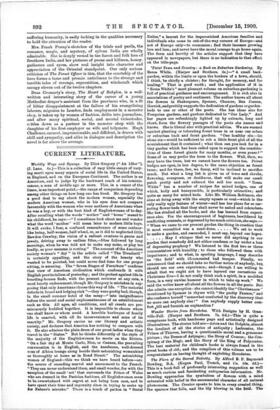The Flora of the Sacred Nativity. By Alfred E. P.
Raymond Dowling, (Began Paul, Trench, and Co. 10s. 6d.)— This is a book full of profoundly interesting suggestion as well as much curious and fascinating antiquarian information. Mr. Dowling approaches the symbolism of flowers with a mind saturated with belief in the sacramental character of all natural phenomena. The Creator speaks to him in every created thing, the sparrow that falls, and the lily blowing in the field. The blossoming of the thorn of St. Joseph of Arima then on the night of the Sacred Nativity is no more improbable to his intelligence than the touch of festive decoration given by an affectionate human parent to a human home on the anniver- sary of the birthday of the child of the house. "The green book 'of Nature is one of God's witnesses to Himself no less than the book of the Scriptures,—in both, deep calls to deep; the strange and inscrutable pleasure that those gifted with the power of 'keen perception feel in the presence of natural beauty or in the -expression of the writings of the Old and New Testament is probably because both appeal to man's inner consciousness, which recognises a fellow-feeling, a family likeness and affinity with itself in the message that both these Bibles convey; it is a touching of the note that vibrates through all, and that is its source and its end, viz., the divine life; a life which sleeps in inorganic matter, it has been said, dreams in the vegetable, wakes in the animal, but in man the child of God speaks; a life gradually -unfolded to the world in the Word made matter, the Word made letter, and finally embodied in the Word made Flesh." But it would be to understate the mystical element in Mr. Dowling's -essays to leave a passage like this to be understood as meaning only that there is what people call a " general influence " of Nature's good in the world of Nature. The aim of the book is to impress upon all who care for flowers, or art, or the ritual of religion, that just as there is a foundation, not arbitrary, for all the different languages in which different nations and kinds of men express the common thoughts of a common humanity, so there is a foundation, not arbitrary, for the sacred meanings and associations primitive and religious minds have found in flowers and herbs ; and that, consequently, sacred art should use the symbolism of flowers, not ignorantly, but with reverent attention to the real tradition of the subject. In a notice necessarily shortened by our wish to speak of the book before the season to which it especially belongs is past, we are unable to touch upon more than one or two points of interest. But one point not to be passed over is the important warning in the first essay, "Flora Sacra," against a spurious ecclesiastical flower-lore taking origin in some works en the Kalendar published in 1824 and 1827 by a certain Dr. Forster. Dr. Forster pretended to have discovered a flower and a legend for every day of the year, and he supported his statements "by curious rhymes, proverbs, and verses, in every sort of language, diverting suspicion from their true authorship by appending to them authorities which have been the puzzle of bibli- ographers and students generally." Mr. Dowling has found a later work by Dr. Forster, published in French at Frankfort-on-Main in 1836, which confesses that these "authorities" were non- 'existent, and that the rhymes, legends, and references were all of the author's invention. Mr. Dowling enumerates the princi- pal works dealing with flower lore and legend which have copied directly or indirectly from Dr. Forster, and thus puts his readers on their guard against prevalent errors connected with his subject. The bulk of his book, however, is occupied not with exposing false traditions, but with building up true. He makes a pleasant suggestion that we should revive the old fashion of church gardens, in which flowers of sacred symbolism should be exclusively grown. And he encourages us to believe that in some rustic customs still existing in Lancashire we have evidence of an older domestication of the Christmas tree in England than is warranted by the usually accepted theory of introduction by the Hanoverian Royal Family.















































 Previous page
Previous page